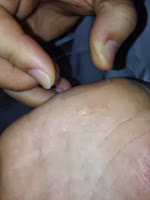MOTILITY TESTING RESULTS AND HYDOLYTIC ENZYMES TEST
Class: Thursday, October 3rd, 2013
In today's lab we started by examining our results of last lab's motility test. We were testing in order to determine whether our mystery bacteria J is motile. If it tested positive, that would mean our bacteria most likely has flagella!! That would be so awesome! Let's take a look!
Unfortunately, our bacteria didn't make any moves. It stayed in the same spot that we "stabbed" it into the slant agar. We can conclude then that our bacteria most likely does not have flagella.
Just to be completely and 100% sure that our bacteria is not motile, we prepared another method--hanging-drop slide. In this rather easy procedure, we started by applying petroleum jelly to the edges of the coverslip. A loopful of bacteria was then transfered onto the coverslip with the inoculating loop. The cavity of the depression slide was centered onto the coverslip until the petrolium jelly created a seal. The slide was quickly turned over and put on the microscope to examine any motility!
 After examining the slide, we can confidently determine that our bacteria does in fact not move.
After examining the slide, we can confidently determine that our bacteria does in fact not move.
Next experiment of the day is a test prepared to determine hydrolytic enzymes.If our mystery bacteria possesses enzymes for a certain nutrient, we will be that much closer to determining the identity of our bacteria. We ran enzyme tests on our mystery bacteria J with starch, casein, gelatin and fat (triglyceride). The procedure was the same from one test to the next. Using aseptic technique, we would transfer our mystery bacteria J onto plates containing the starch, casein, gelatin and fat with an inoculate loop. After making all of the transfers, we put the tests in the incubator. I can hardly wait to see our results and what our mystery bacteria J 'eats'!
 |
| Transfer bacteria J onto starch plate |
 |
| Inoculating bacteria J |
 |
| Inoculating bacteria J for a 2nd time |
 |
| Transfer bacteria J onto casein plate |
 |
| Inoculating bacteria J for a 3rd time |
 |
| Transfer to a gelatin slant stabbing |
 |
| Inoculating bacteria J a 4th time |
 |
Transfer to a tributyrin agar plate |
One last test we prepared today with our bacteria was the litmus milk reactions test. The contents in the litmus milk is for starters litmus (go figure)
which is used to indicate thepH of the bacteria, protein, and lactose.
This test will tell us whether or not our mystery bacteria has the ability to
metabolize lactose and protein, and whether its acidic or not.




No comments:
Post a Comment